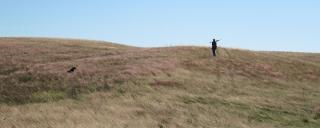
Planted or Tame Grassland
Area: unknown, estimate 2-5 million acres
Description and Overall Condition: This landscape component includes land that had been converted to cropland and re-planted to hayland, tame or native grasses. Hayland constitutes approximately 5% of the state. Planted alfalfa is the most common hay crop. Hay may be cut up to four or five times throughout the growing season. Haying earlier than July 15, or before nesting birds have fledged, can result in bird mortality from the machinery. The Conservation Reserve Program (CRP) was established in the 1985 Farm Bill as a tool for producers to conserve marginal soil by retiring cropland from production for 10 to 15 years. The CRP program provides income for producers and delivers unprecedented landscape scale wildlife habitat and conservation of soil and water. Larger tracts of CRP, particularly in juxtaposition with other existing native or planted grassland, are more attractive and more productive than smaller tracts of CRP. These larger tracts, in concert with surrounding landscape features, are a focus area of this landscape component. CRP is generally left idle although managed and emergency haying and grazing of CRP may be allowed. Producers can hay or graze CRP once every three years, keeping outside of the primary nesting season defined as April 15-August 1. The number of acres of hayed and grazed CRP has and continues to increase as a result, which can be beneficial to many wildlife species. More than half of the CRP contracts have expired since 2007 and obstacles for reauthorization of the program limits new contracts. The loss of CRP on the North Dakota landscape will be detrimental to wildlife populations. Tame grasslands are widespread throughout the state on wildlife management areas, waterfowl production areas, and other publicly owned land.
Predominant Natural Vegetation
Grasses
smooth brome, crested wheatgrass, intermediate wheatgrass, tall wheatgrass, big bluestem
Forbs
alfalfa, sweet clover
Associated Species of Conservation Priority
Birds
American bittern, northern pintail, lesser scaup, northern harrier, swainson’s hawk, sharp-tailed grouse, greater prairie-chicken, willet, upland sandpiper, marbled godwit, long-billed curlew, wilson’s phalarope, short-eared owl, burrowing owl, loggerhead shrike, lark bunting, grasshopper sparrow, baird’s sparrow, Le conte’s sparrow, Nelson’s sparrow, chestnut-collared longspur, dickcissel, bobolink, western meadowlark
Mammals
arctic shrew, pygmy shrew, plains pocket mouse, hispid pocket mouse, richardson’ ground squirrel, plains spadefoot
Reptiles/Amphibians
canadian toad, smooth green snake, plains hog-nosed snake
Insects
monarch butterfly, regal fritillary
Other Characteristic Wildlife
Birds
American wigeon, green-winged teal, mallard, blue-winged teal, Northern shoveler, gadwall, red-tailed hawk, gray partridge, ring-necked pheasant, killdeer, mourning dove, Western kingbird, Eastern kingbird, horned lark, American crow, common yellowthroat, vesper sparrow, Savannah sparrow, Western meadowlark, red-winged blackbird, brown-headed cowbird
Mammals
Northern short-tailed shrew, white-tailed jackrabbit, snowshoe hare, Franklin’s ground squirrel, thirteen-lined ground squirrel, Northern pocket gopher, olive-backed pocket mouse, Western harvest mouse, deer mouse, Northern grasshopper mouse, prairie vole, meadow vole, meadow jumping mouse, Western jumping mouse, coyote, red fox, raccoon, badger, striped skunk, white-tailed deer, moose
Reptiles/Amphibians
American toad, Great Plains toad, Woodhouse’s toad, Northern leopard frog, chorus frog, tiger salamander, plains garter snake, common garter snake
For more detailed information about this topic, please see the North Dakota Wildlife Action Plan.
